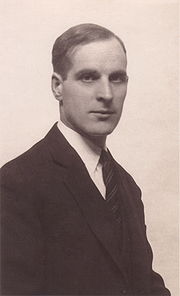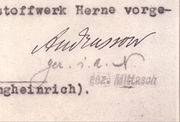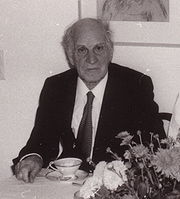
Leonid Andrussow
Encyclopedia



Andrussow oxidation
The Andrussow process is an industrial process for the production of hydrogen cyanide from methane and ammonia in the presence of oxygen and a platinum catalyst....
.
Biography
Leonid Andrussow was born in Riga, Russian Empire. His father Woldemar Georg, who earned his law degree at the University of St. Petersburg, was general counsel for the Russian Railroads in Riga. He was of Swedish and Baltic ancestry, the original family name being Andersohn. Leonid Andrussow was graduated in chemical engineering from the University of Riga. During the Russian Revolution, he served as a WhiteWhite movement
The White movement and its military arm the White Army - known as the White Guard or the Whites - was a loose confederation of Anti-Communist forces.The movement comprised one of the politico-military Russian forces who fought...
cavalry officer, and in 1920 was captured by the Bolshevik
Bolshevik
The Bolsheviks, originally also Bolshevists , derived from bol'shinstvo, "majority") were a faction of the Marxist Russian Social Democratic Labour Party which split apart from the Menshevik faction at the Second Party Congress in 1903....
s in Turkestan. He was imprisoned on an island near Baku
Baku
Baku , sometimes spelled as Baki or Bakou, is the capital and largest city of Azerbaijan, as well as the largest city on the Caspian Sea and of the Caucasus region. It is located on the southern shore of the Absheron Peninsula, which projects into the Caspian Sea. The city consists of two principal...
, and then transferred to the infamous Cheka prison, Lubianka in Moscow. He was released after only three months, when it became apparent that he had malaria. He moved to Berlin, where he attended the Friedrich Wilhelms University
Humboldt University of Berlin
The Humboldt University of Berlin is Berlin's oldest university, founded in 1810 as the University of Berlin by the liberal Prussian educational reformer and linguist Wilhelm von Humboldt, whose university model has strongly influenced other European and Western universities...
, earning his doctorate in chemistry in 1926 under Walter Nernst. His thesis title was "Über die katalytische Ammoniakoxydation." In 1926, he married Irmgard Von Bredow, with whom he had six children. In 1927, he began his research in rocket fuels, working at BASF
BASF
BASF SE is the largest chemical company in the world and is headquartered in Germany. BASF originally stood for Badische Anilin- und Soda-Fabrik . Today, the four letters are a registered trademark and the company is listed on the Frankfurt Stock Exchange, London Stock Exchange, and Zurich Stock...
, then IG Farben
IG Farben
I.G. Farbenindustrie AG was a German chemical industry conglomerate. Its name is taken from Interessen-Gemeinschaft Farbenindustrie AG . The company was formed in 1925 from a number of major companies that had been working together closely since World War I...
, in Ludwigshafen. According to Leon Green, Jr., of the Air Force Systems Command, Andrussow was probably the first person, in 1937, to conceive of the idea of a rocket propellant consisting of both liquid and solid components. See External link (p. I.6). He continued his work in catalytical processes, registering many patents for I.G. Farben, including that which became known as the "Andrussow Process." From 1946 on, he lived in Grenoble, and later in Paris. He became a member of the French Academy of Sciences, and in 1969, edited Bd. II, Eigenschaften der Materie in ihren Aggregatzuständen. Teil 5a, Transportphänomene I (Viskosität und Diffusion) of the Landolt-Börnstein Zahlenwerte und Funktionen. He died in Paris at the age of 92 years.
Work
- Based on the theory of fast running catalytical processes, which was developed in 1927, the oxidative synthesis of hydrogen cyanide from ammonia and methane was found in 1930 and developed to an industrial stage. This process, which is known as the “Andrussow Process”, is the most important method for the industrial production of hydrogen cyanide as a preliminary product for the synthesis of polyamide 66 (nylonNylonNylon is a generic designation for a family of synthetic polymers known generically as polyamides, first produced on February 28, 1935, by Wallace Carothers at DuPont's research facility at the DuPont Experimental Station...
) and for acrylic glassAcrylic glassPoly is a transparent thermoplastic, often used as a light or shatter-resistant alternative to glass. It is sometimes called acrylic glass. Chemically, it is the synthetic polymer of methyl methacrylate...
(polymethyl methacrylate). - 1932 Work on the catalytical alkylation with ether for the industrial production of purest dimethylaniline.
- Conversion of tetrachlorethane to methylene chloride and trichlorethylene.
- Numerous works on rocket fuels, among others the introduction of the system nitric acid and amines or other fuels. Collaboration during the development of the V-2 rocketV-2 rocketThe V-2 rocket , technical name Aggregat-4 , was a ballistic missile that was developed at the beginning of the Second World War in Germany, specifically targeted at London and later Antwerp. The liquid-propellant rocket was the world's first long-range combat-ballistic missile and first known...
in Stromberg. Addition of laughing gas for the substantial increase of flying velocity at high altitudes. - Advisory function in France coupled to the further development of the theory of catalytical processes: Sulphuric acid anhydride, formaldehyde, synthesis of ammonia.
- Numerous studies on the transport properties of gases and liquids, inclusive macromolecules.
- Author of Transportphänomene I (Viskosität und Diffusion), Bd. II, Teil 5a (1969) of Landolt-BörnsteinLandolt-BörnsteinLandolt–Börnstein is a systematic and extensive data collection in all areas of physical sciences and engineering published by Springer Science+Business Media. Originally, the project started with the first work published in 1883 by the physicist Hans Heinrich Landolt and the chemist Richard...
Zahlenwerte und Funktionen aus Physik, Chemie, Astronomie, Geophysik und Technik. 6. Aufl.
In 1927 he demonstrated that methane
Methane
Methane is a chemical compound with the chemical formula . It is the simplest alkane, the principal component of natural gas, and probably the most abundant organic compound on earth. The relative abundance of methane makes it an attractive fuel...
and ammonia
Ammonia
Ammonia is a compound of nitrogen and hydrogen with the formula . It is a colourless gas with a characteristic pungent odour. Ammonia contributes significantly to the nutritional needs of terrestrial organisms by serving as a precursor to food and fertilizers. Ammonia, either directly or...
react in the presence of oxygen
Oxygen
Oxygen is the element with atomic number 8 and represented by the symbol O. Its name derives from the Greek roots ὀξύς and -γενής , because at the time of naming, it was mistakenly thought that all acids required oxygen in their composition...
at about 1200 °C over a platinum
Platinum
Platinum is a chemical element with the chemical symbol Pt and an atomic number of 78. Its name is derived from the Spanish term platina del Pinto, which is literally translated into "little silver of the Pinto River." It is a dense, malleable, ductile, precious, gray-white transition metal...
catalyst:
The energy needed for the reaction is provided by the part oxidation of methane and ammonia.
Patents
- US-Patent 1,934,838 (Production of Hydrocyanic Acid) from 1930

